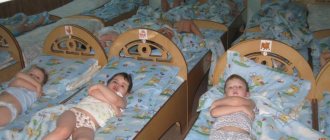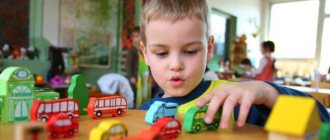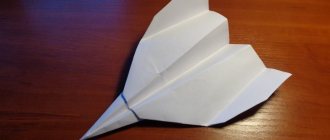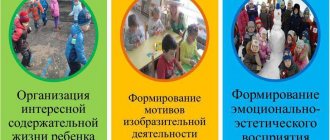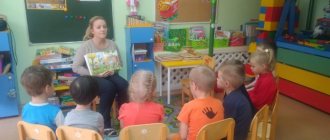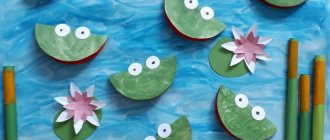Expand the diversity of the educational space with MAAM.
Contained in sections:
- Circle work. Additional education 3797
- Educational programs, basic and additional 5308
- Professional pedagogical education, students 195
By groups:
- Senior group
- Preparatory group
Showing publications 1-10 of 484. All sections | Short-term educational practice. COP in kindergarten
New
Photo
The best
Short-term educational practice “Insects” Municipal autonomous preschool educational institution “ Kindergarten No. 400 ”
Perm Approved by the expert and methodological council of the MADOU
"
Kindergarten No. 400 " in Perm Order No._ from_ Head of the preschool educational institution_
Short-term educational practice for children of primary preschool...
Technological map of the educational program for preschool children "New Year's toy" Technological map of short-term educational practice ( KOP)
optional for preschool children
“New Year's toy”
Abstract In the classes of the developed
short-term educational practice, children will learn how to make bookmarks for books. Purpose Making a bookmark for...
Short-term educational practice in kindergarten using applications. Junior group
Short-term educational practice on broken appliqué “Lessons in unusual creativity”
Developed by: Golubeva Maria Andreevna, Teacher of junior group No. 4 Berezniki, 2022. Short-term educational practice “Lessons of unusual creativity” Brief description of this practice: Developed by teacher: Golubeva Maria Andreevna. Age category of children: 3 – 4 years. Number of participants: up to 12 people. Number of classes: 4. Duration of classes - 20 minutes. The focus of practice is technical. The educational field (FSES) is an artistic and aesthetic field. Relevance
The development of children's creativity is a pressing problem of modern pedagogy and sets the main goal for the education system - to educate the younger generation in a creative approach to transforming the world around them.
We must cultivate in our children inquisitiveness, ingenuity, initiative, imagination, fantasy - that is, those qualities that find vivid expression in children's creativity. Goal: to develop children's artistic creativity in children, using cut-out appliqué as an unconventional form of working with paper. Literature: 1. Maksimova N. M. Kolobova T. G. Application. Educational visual materials for teaching primary preschool age, Moscow, 1998 2. Volchkova V.N., Stepanova N.V. Lesson notes for the second junior group of kindergarten. Voronezh, 2004. Long-term plan for short-term educational practice on cut-out applique “Lessons in unusual creativity” Lesson I Break-out applique “Leaves are falling, falling, leaves are falling in our garden...”
Objectives: To develop children’s ability to create the simplest composition - falling leaves using torn pieces of colored paper ;
development of fine motor skills. Strengthen the skills of smearing pieces of paper with glue and gluing them. To evoke in children an emotional attitude towards natural phenomena. Plan of activities: 1. Admiring the falling leaves from the window. 2. Discussion of leaf color. 3. Demonstration of the technique of tearing colored paper. 4. Show adults how to stick leaves. 5. Independent work of children. 6. Examination of the resulting paintings. Material: 1. Landscape sheets with graphic drawings of trees and bushes without leaves. 2. Colored paper in yellow and orange. 3. Glue 4. Brushes 5. Napkins 6. Illustration of an autumn park Predicted result: Exhibition for parents “Falling Leaves”. Lesson II Tattered applique “Fly agaric”
Objectives: To develop children’s ability to design a fly agaric using torn pieces of paper;
development of fine motor skills. Strengthen the skills of smearing pieces of paper with glue and gluing them. To evoke in children an emotional attitude towards natural phenomena. Plan of activities: 1. Examination of fly agaric mushrooms in pictures. 2. Discussion of the color of the fly agaric. 3. Demonstration of the technique of tearing colored paper. 4. Show adults how to stick white dots. 5. Independent work of children. 6. Review of works. Material: 1. Album sheets with a pattern of a fly agaric with a red hat without white dots. 2. White paper. 3. Glue. 4. Brushes. 5. Napkins. 6. Pictures of fly agarics. Predicted result: Exhibition “Amanitas in the Forest” Lesson III Tattered applique “First Snow”
Objectives: To develop children’s ability to create the simplest composition - snowfall using torn pieces of white paper;
development of fine motor skills. Strengthen the skills of smearing pieces of paper with glue and gluing them. To evoke in children an emotional attitude towards natural phenomena. Plan of activities: 1. Admiring the first snow from the window. 2. Discussion of the color of snowflakes. 3. Demonstration of paper tearing techniques. 4. Show adults how to stick snowflakes. 5. Independent work of children. 6. Examination of the resulting paintings. Material: 1. Sheets of blue cardboard with a graphic design of clouds. 2. White paper. 3. Glue 4. Brushes 5. Napkins 6. Snowfall illustrations. Predicted result: Exhibition of works “First Snow” IV lesson Tattered applique “Painted plate”
Objectives: Develop children’s ability to decorate a plate using torn pieces of paper; development of fine motor skills. Strengthen the skills of smearing pieces of paper with glue and gluing them. Evoke a sense of beauty in children. Plan of activities: 1. Examination of plates with different patterns. 2. Discussion of the color of the pattern. 3. Demonstration of paper tearing techniques. 4. Show adults how to stick snowflakes. 5. Independent work of children. 6. Examination of the resulting paintings. Material: 1. Album sheets with a graphic image of a plate. 2. Colored paper. 3. Glue 4. Brushes 5. Napkins 6. Plates with different images of patterns. Predicted result: Exhibition of works “Plates”
Appendix
I Lesson Break-out applique “Leaves are falling, falling, leaves are falling in our garden...”
Lesson II: Disruptive applique “Fly agarics”
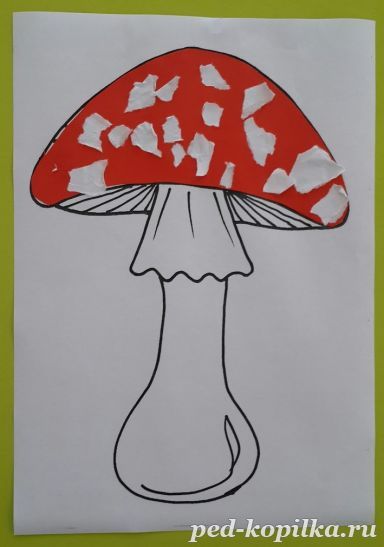
Lesson III: Cut-out applique “First snow”
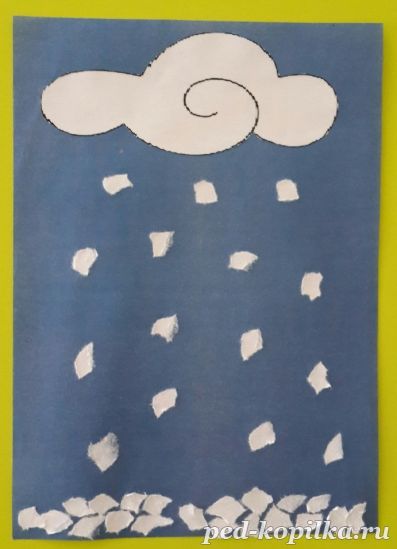
Lesson IV: Broken applique “Painted plate”
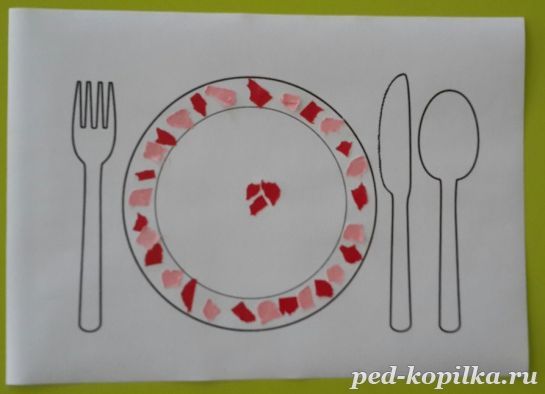
We recommend watching:
Application from paper napkins for children on the theme of Winter Application on the theme of Spring for kindergarten. Junior group Lesson notes for the 2nd junior group. Autumn applique DIY applique on the theme: Spring for older children
Similar articles:
Application for children 2-3 years old. Umbrella
What tasks does the COP solve in a preschool educational institution?
CEP technical orientation in preschool educational institutions, carried out in preschool institutions, allows you to solve the following problems:
- Educational - children learn various design techniques.
- Developmental - children train logic and thinking, imagination and fine motor skills.
- Educational - the technique allows you to instill perseverance, determination, and patience in a preschooler.
The work can use the methods of observation, examination, demonstration, verbal method and the method of plot games.
All of them are equally effective, but an important condition for the lesson is a well-thought-out plot and positive motivation.
In technical design classes, children create crafts based on real-life objects or fantasize about fairy tales, poems or songs.
Organization of activities of COPs as a means of expanding the educational space in preschool educational institutions
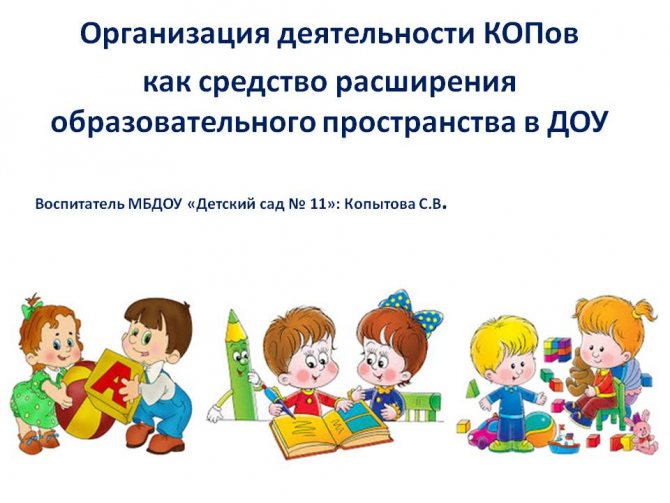
And the more complete and varied a child’s activity is, the more significant it is for the child and corresponds to his nature, the more successful his development is. Intensive intellectual, emotional and personal development, the well-being of the child and social status are associated with mastering the position of the creator of children's activities. Expanding the range of educational services for children of early and preschool age, taking into account their age and individual characteristics, health status, and family needs is one of the priorities of preschool education. Building an individual path of development through the acquisition of new skills, abilities, and personality traits in the created social situation of a child’s development is the essence of building a system of short-term educational practices of choice. The child’s activity is stimulated by the freedom to choose activities of his own free will, under the influence of gaming materials that attract his attention.
The program of short-term educational practices assumes that the construction of educational activities occurs on the basis of the individual characteristics of each child, in which the child himself becomes active in choosing the content of his education. The child will be able to acquire new skills, abilities, and personality traits that will allow him to build an individual development path.
The direction of short-term educational practices comes from the needs of the family and the interests of the child. Short-term educational practices take the format of practice-oriented courses aimed at developing specific practical skills in a specific activity and creating your own product while attending the course.
MBDOU "Kindergarten No. 11" in the 2015-2016 academic year began to test the design of an institutional system of short-term educational practices.
Short-term educational practices (SEPs) are practices that allow a child to achieve a specific result in a small number of lessons. This is a practice-oriented completed educational activity for children together with a teacher, lasting 4–8 academic hours, lasting 20–25 minutes.
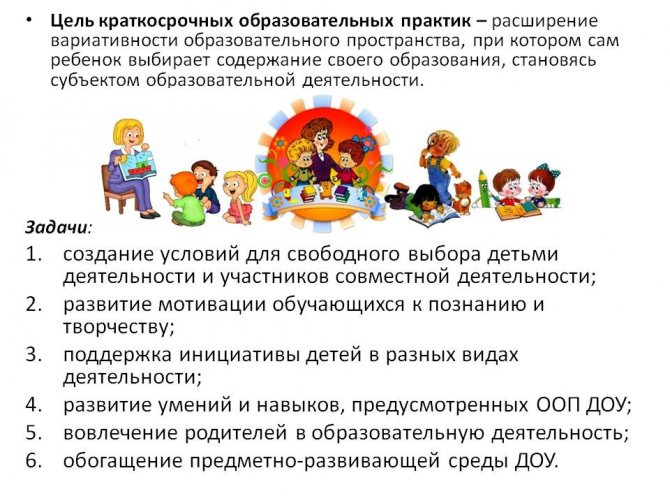
The goal of short-term educational practices is to expand the variability of the educational space, in which the child himself chooses the content of his education, becoming the subject of educational activities. At the same time, the following tasks are solved: creating conditions for children to freely choose activities and participants in joint activities; developing students’ motivation for knowledge and creativity; supporting children's initiative in various activities; development of skills and abilities provided for by the preschool education educational program; involving parents in educational activities; enrichment of the subject-developmental environment of preschool educational institutions.
Optional CEP in preschool educational institutions is carried out in the following areas: social and communicative, cognitive, speech, artistic and aesthetic, physical. The implementation of elective CEP is carried out within the framework of the main general education program of preschool education in the part formed by participants in educational relations according to proprietary and authorized programs. Classes are structured taking into account the age and individual characteristics of children. Areas of activity of the CoP are optional; their number can be supplemented (changed) in accordance with the request of children and parents (legal representatives). The results of mastering the CEP can be presented in the form of the child’s own product of activity or the development of a specific practical skill.
In September 2015, the preschool educational institution established an educational order in the form of a parent survey. Parents equally noted educational practices (clubs) in the main areas of development and education of children (artistic-aesthetic, social-communicative, physical, speech, cognitive). During the year, teachers at our preschool educational institution developed and implemented 34 educational practices in these areas of child development and 1 CEP program for parents. Short-term educational practices are aimed at children aged 2–7 years.
All age groups of the kindergarten and all preschool teachers are involved in testing educational practices. The implementation of the COP is carried out quarterly throughout the calendar year: September - November, December - February, March - May, June - August. During the quarter, the child will have the opportunity to master 2-3 educational practices, and during the year, 6-10 practices. To conduct CEP, children are grouped into subgroups of 9–10 people. Time: from 11.50 or 12.15, from 16.30 or 17.00 (other times are possible).
Venue: premises of the music and physical education hall, group rooms, psychologist’s office, speech therapist. The choice of CEP is carried out once a quarter for 1-2 educational practices. In the autumn quarter, the choice of practice is proposed to be determined by parents together with the child. For subsequent practices, the child can choose the COP himself.
To make the choice of educational centers, parents and children are offered to advertise all educational practices on an information sheet (photos of children's activities, photo fragments with the activities of children attending a particular educational center).
Children make their own choice by choosing a symbol-picture (photo reflecting the direction of the CPC activities). Using these pictures, the group teacher creates a list of children for COPs. After the child passes the COP in the next school year, we plan to issue a certificate that reflects the child’s success in this area, after which this certificate can be included in the preschooler’s portfolio.
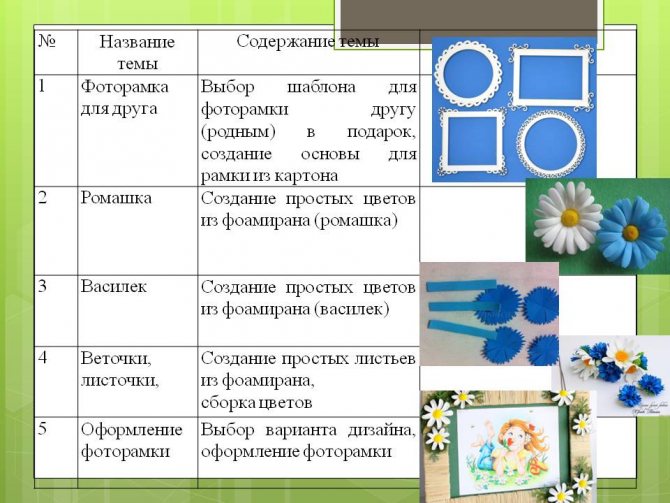
Analyzing the activities of preschool educational institutions in implementing COP programs, it should be noted that the teaching staff was quite actively involved in this activity, work experience in this area at all levels was generalized. Relevant for the present moment is the development of CEP programs in the following areas: social and communicative development, development of prerequisites for engineering thinking.
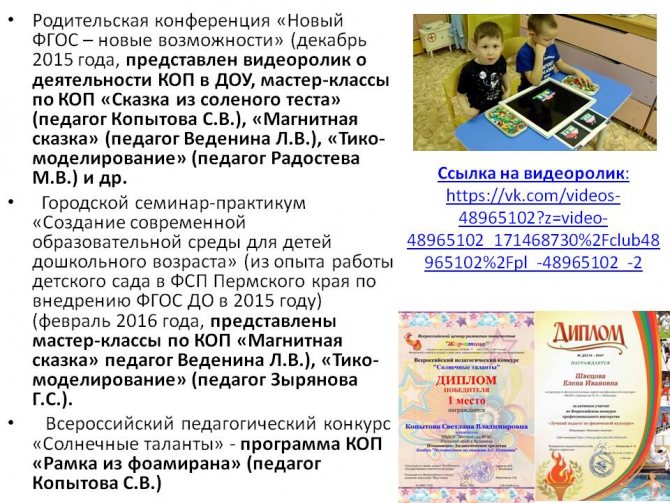
Why is a technical COP needed in a preschool educational institution?
Short-term construction practice is very important for children, especially five-year-olds. By creating his own project, the child learns synthesis and analysis, which is so necessary for learning at school. While examining the sample, the preschooler comes up with a new design for it and learns to correct the mistakes made. Such training perfectly stimulates the development of thinking. Games with Lego constructors can be started from the middle group.
Such material will help solve many problems and problems in the development of preschoolers. It must be included in the arsenal of technical-oriented educational programs in preschool educational institutions. “Lego” not only helps develop color perception, logic and spatial imagination, but also activates finger tenacity. The child will not get bored with this construction set, because with its help you can create thousands of different crafts. Preschoolers really appreciate this variety.
Drawing up a technological map by the teacher
Before starting work on the program, the teacher must create a technological map of the COP of a technical focus in the preschool educational institution. It is compiled very simply. To begin, select the name of the activity, for example “Spaceship”, “Merry Men”, “Butterflies”. Indicate the age of the children, the duration of the practice, its tasks, and goals. The resources used and the desired result also need to be included in the map. The last thing that needs to be indicated is what key competencies will be developed in children during the CEP of a technical focus in a preschool educational institution.
An example of such competencies:
- technological - learning to assemble a dog, learning to assemble a car according to a diagram, learning to connect elements into a whole model;
- informational - learn to choose material for work, learn to choose non-standard material for creativity, learn to use information when working with other materials;
- social-communicative - learn to speak correctly with peers and adults, learn to interact with peers.
